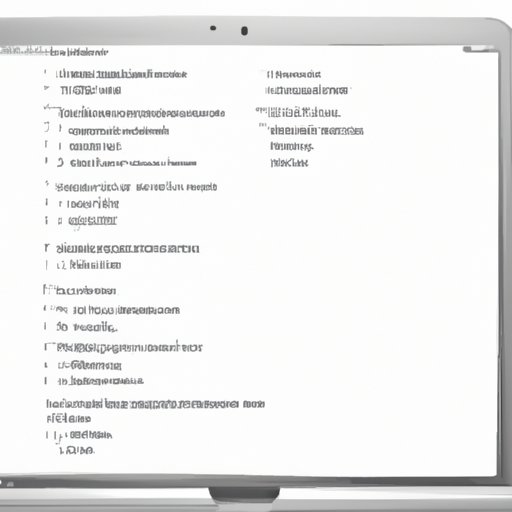I. Introduction
Have you ever needed to take a quick screenshot on your MacBook? Whether it’s for work, school, or personal use, knowing how to capture images on your MacBook can be a valuable skill. In this guide, we’ll explore different types of screenshots, keyboard shortcuts, top software tools for taking screenshots, multimedia guides, and troubleshooting tips for common issues.
II. A Step-by-Step Guide: How to Take a Screenshot on MacBook
There are three types of screenshots you can take on a MacBook: full screen, window, and selection. Let’s explore each one in detail.
Full Screen Screenshot
To capture an image of your entire screen, press the Command (⌘) + Shift + 3 keys simultaneously. The screenshot will be saved to your desktop.
Window Screenshot
To capture an image of a specific window, hover your mouse over the window you want to screenshot and press the Command (⌘) + Shift + 4 keys simultaneously. Your cursor will turn into a crosshair. Click the window you want to capture. The screenshot will be saved to your desktop.
Selection Screenshot
To capture a specific section of your screen, press the Command (⌘) + Shift + 4 keys simultaneously. Your cursor will turn into a crosshair. Click and drag your cursor to select the section you want to capture. Release the cursor to take the screenshot. The screenshot will be saved to your desktop.
When you take a screenshot, a thumbnail preview will appear in the bottom right corner of your screen. You can click on the preview to access the screenshot, or you can find it on your desktop.
III. The Keyboard Shortcut Guide to Taking Screenshots on MacBook
Keyboard shortcuts can make taking screenshots even easier. Here’s a list of shortcuts you can use to take different types of screenshots on a MacBook:
- Command (⌘) + Shift + 3: Full screen screenshot
- Command (⌘) + Shift + 4: Selection screenshot
- Command (⌘) + Shift + 4, then Spacebar: Window screenshot
- Control + Command (⌘) + Shift + 3: Full screen screenshot saved to clipboard
- Control + Command (⌘) + Shift + 4: Selection screenshot saved to clipboard
- Control + Command (⌘) + Shift + 4, then spacebar: Window screenshot saved to clipboard
To remember these shortcuts, try making flashcards or practicing each one until they become second nature.
IV. The Top 5 Screenshot Tools for MacBook
If you want to take your screenshots to the next level, consider using software tools designed specifically for the task. Here are five of the best screenshot tools for MacBook:
- Snagit: This is one of the most popular screenshot tools, offering a range of features such as image annotations, video recording, and the ability to scroll capture long web pages. The downside is that it’s not free, but a 15-day free trial is available.
- Monosnap: This software is free and offers image editing tools such as text overlays, arrows, and blur effects. It also has a cloud storage feature for easy sharing of your screenshots.
- Lightshot: A free tool with a simple interface and easy-to-use features such as crop, highlight, and resize.
- Skitch: This is a user-friendly screenshot tool with an array of editing tools such as text, shapes, and arrows. It offers a free basic plan as well as a more advanced plan with additional features.
- Jing: This software offers both screenshots and video recording options. It’s free and also offers cloud storage for easy sharing.
To download and install any of these tools, visit their websites and follow the instructions provided.
V. Multimedia Guide: How to Record Videos and Take Screenshots on Your MacBook
If you want to record videos or create custom screenshots on your MacBook, the QuickTime Player is the best software tool for the job. Here’s how to use it:
To Record a Video:
- Open QuickTime Player from your Applications folder.
- Click on “File” and then “New Screen Recording.”
- Press the “Record” button and begin recording your screen.
- Press “Stop” to end your recording and save the video to your designated location on your MacBook.
To Create Custom Screenshots:
- Open QuickTime Player from your Applications folder.
- Click on “File” and then “New Screen Recording.”
- Click on the dropdown arrow next to the Record button.
- Select “Built-in Microphone” and “Show Mouse Clicks in Recording” if desired.
- Click “Record” then follow the processes outlined in section two to complete the screenshot process.
VI. Taking Screenshots on Your MacBook: Common Issues and Troubleshooting Tips
Here are some common issues users may face when taking screenshots on a MacBook:
- Cannot find the screenshot: If you took a screenshot but can’t locate it, try searching for it in the Finder search box.
- Error message: If you receive an error message when taking a screenshot, make sure you have enough disk space on your MacBook. You can also try restarting your MacBook or updating your software.
- Wrong type of screenshot: If you accidentally took the wrong type of screenshot, simply delete it and try again.
By following the troubleshooting tips above, you can avoid these issues and take screenshots with ease.
VII. Conclusion
In conclusion, taking screenshots on a MacBook is a valuable skill for many users. Whether you need to capture an image for work or personal use, knowing how to do so quickly and efficiently can save you time and frustration. By following the step-by-step guide, utilizing keyboard shortcuts, exploring software tools, and understanding common issues, you can easily master the art of taking screenshots on your MacBook. Remember to practice and experiment with different tools and techniques to see what works best for you.
